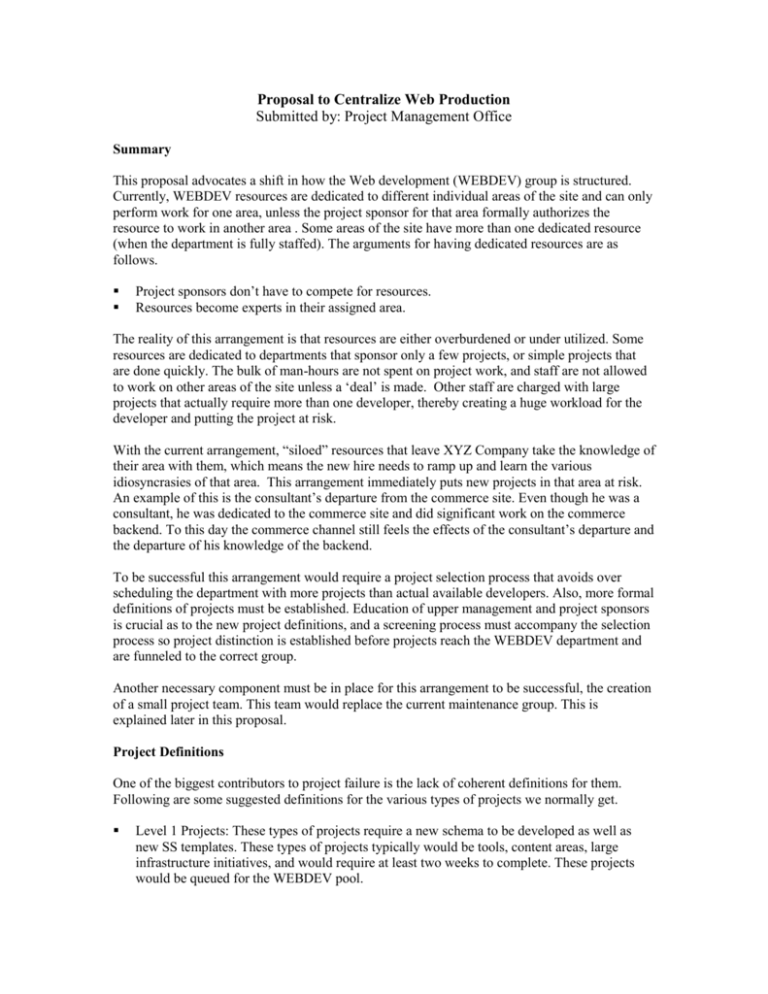The diagram describes how projects would flow with the web
advertisement

Proposal to Centralize Web Production Submitted by: Project Management Office Summary This proposal advocates a shift in how the Web development (WEBDEV) group is structured. Currently, WEBDEV resources are dedicated to different individual areas of the site and can only perform work for one area, unless the project sponsor for that area formally authorizes the resource to work in another area . Some areas of the site have more than one dedicated resource (when the department is fully staffed). The arguments for having dedicated resources are as follows. Project sponsors don’t have to compete for resources. Resources become experts in their assigned area. The reality of this arrangement is that resources are either overburdened or under utilized. Some resources are dedicated to departments that sponsor only a few projects, or simple projects that are done quickly. The bulk of man-hours are not spent on project work, and staff are not allowed to work on other areas of the site unless a ‘deal’ is made. Other staff are charged with large projects that actually require more than one developer, thereby creating a huge workload for the developer and putting the project at risk. With the current arrangement, “siloed” resources that leave XYZ Company take the knowledge of their area with them, which means the new hire needs to ramp up and learn the various idiosyncrasies of that area. This arrangement immediately puts new projects in that area at risk. An example of this is the consultant’s departure from the commerce site. Even though he was a consultant, he was dedicated to the commerce site and did significant work on the commerce backend. To this day the commerce channel still feels the effects of the consultant’s departure and the departure of his knowledge of the backend. To be successful this arrangement would require a project selection process that avoids over scheduling the department with more projects than actual available developers. Also, more formal definitions of projects must be established. Education of upper management and project sponsors is crucial as to the new project definitions, and a screening process must accompany the selection process so project distinction is established before projects reach the WEBDEV department and are funneled to the correct group. Another necessary component must be in place for this arrangement to be successful, the creation of a small project team. This team would replace the current maintenance group. This is explained later in this proposal. Project Definitions One of the biggest contributors to project failure is the lack of coherent definitions for them. Following are some suggested definitions for the various types of projects we normally get. Level 1 Projects: These types of projects require a new schema to be developed as well as new SS templates. These types of projects typically would be tools, content areas, large infrastructure initiatives, and would require at least two weeks to complete. These projects would be queued for the WEBDEV pool. Level 2 Projects: These types of projects would not require any database modifications. Typically these would be modifications on existing functionality of tools and content areas of the site or the creation of flat content. These types of projects would require one week or less to complete, and would be queued for the small project team. Maintenance Projects: Broken functionality, missing images, type changes in templates, etc. Sponsors would submit their bugs to the small project team’s project manager. These projects would be screened and then scheduled with a small project team resource. Project Flow With the web developers arranged in a pool environment as opposed to being dedicated to a single area, projects would flow as follows: Production projects for the coming month are chosen at the priorities meeting. Because we currently have 11 WEBDEV developers including tech leads, only 11 projects requiring WEBDEV production resources can be chosen for the month. As production resources are added the number of projects increases accordingly. The projects are chosen based on criteria established by upper management (ROI, strategic, web site traffic metrics etc.). There are approximately eight project sponsors that regularly use WEBDEV resources. Each sponsor is awarded a project per month if they have a project(s) on the docket and if the project(s) passes the selection criteria. WEBDEV resources are assigned projects based on priority and seniority; that is, the project with the highest priority gets assigned the most senior developer(s). Developers are assigned new projects upon completing their current project. Developers rotate through editorial areas as needed. A roster of upcoming projects could be published so developers would have the option of requesting upcoming projects. Project managers maintain a project portfolio and keep upper management apprised of overall project status. Project managers also take a more active role in resource allocation due to their knowledge of upcoming projects and team member attributes (skill level, personality etc.). Benefits: Project selection becomes critical and requires preplanning and business justification to be established before projects are submitted for review. This decreases the number of trivial or substandard projects from taking up valuable production resources. Developers rotate throughout the various areas of the site and gain a global understanding of the site structure and functionality. By rotating, the odds of developers getting bored or feeling under-challenged are diminished. The ability to choose an upcoming project adds interest on the developer’s part, which increases the quality of their work. Knowledge is shared throughout the staff as opposed to having ‘experts’ in one particular area of the site. The risk of knowledge leaving the company upon a developer’s departure is removed. Risks: Project sponsors who are used to having a dedicated resource will resist the new system. Increased squabbling between project sponsors given the reality that only a certain number of projects are initiated per month based on the availability of resources. Assumptions for success: Senior management has to be involved in mandating the shift to a pool from a dedicated environment. Beyond mandating the shift, management has to understand and support the shift. A method for dealing with small projects is in place and staffed. Project definitions are established and honored. Small Project Team The Small project team would evolve from the current maintenance department. The current maintenance department is staffed with resources who are somewhat under trained and overworked. They are besieged by requests sent directly to them from project sponsors. There is currently no project management for this group. During slow times this arrangement can almost work; however, as the development pace picks up this arrangement is doomed. The assumption that has to be communicated to the entire WEBDEV group is “We built it, we have to support it.” The small project team provides support for the WEBDEV group’s applications. Some assumptions for success of this group are: Developer documentation of applications should be thorough and accessible (via a knowledge management intranet). A milestone is built into project plans for developers meeting with the small project team to discuss the documentation and functionality of completed applications. A project manager is assigned to the group that handles scheduling of all small project group work as well as resource allocation. Small Project Team Structure The structure of this team would be as follows: Project Manager: Responsible for coordinating with project sponsors, writing specs, allocating resources, creating project timelines, tracking milestones, and screening project requests. The project manager would be a member of the project management group and would be a rotating position. This position could be an entry level assignment for project managers. It would afford new project managers a quick and thorough indoctrination into the WEBDEV process. HTML developers (2): Similar to the positions currently held by Z. and M., the HTML resources would, however, be trained in application development and would be assigned WEBDEV maintenance tasks regularly. The HTML resource role should be a stepping stone to a full-time WEBDEV role and the career path and career momentum established. Currently the career path may exist in theory, but a time has to be implemented so the HTML developer knows when he can expect to be promoted up the chain. Web developers (3-4): This team should be staffed with at least three Web developers. This should be an entry level position and, similar to the HTML developer, the career path is established, communicated, and supported. These developers would be assigned to the small project team for a certain amount of time before being promoted into the general WEBDEV pool. Rotating Web developer (1): All staff in the production department should be rotated through the small project team for a certain amount of time. This would bring knowledge and experience to the group as well as keep all members of the team updated on the entire site and provide all resources with knowledge of their peers’ code.







